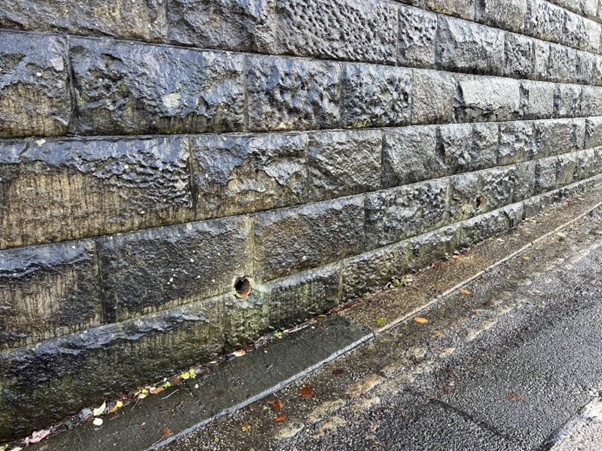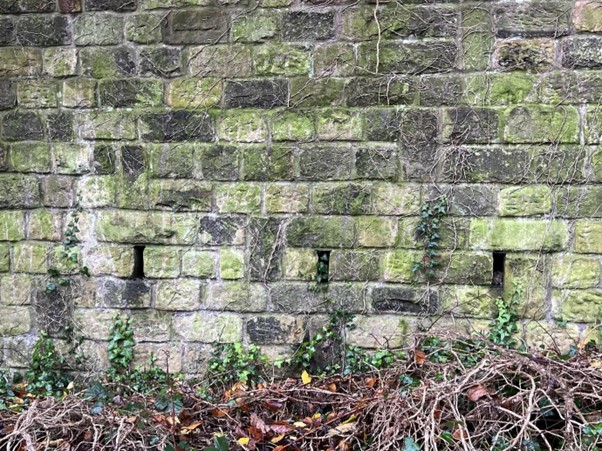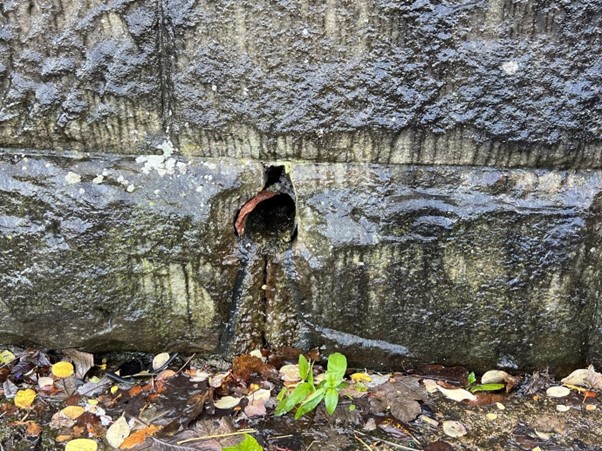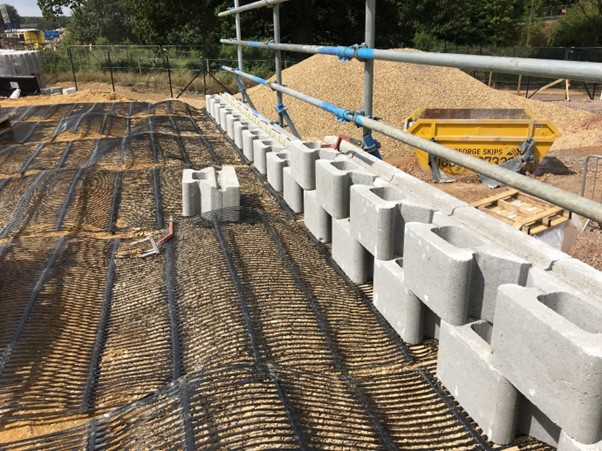Weep Holes in retaining walls: What are they?
by Mitul Dalwadi, on November 23, 2023
.jpg)
Figure 1 - Weep holes in a concrete wall with staining. Effective but not attractive
Weep holes in retaining walls are familiar to us all. We have walked past concrete or masonry walls and seen the series of holes close to the ground, some with water trickling or dripping out, with a trail of moist green algae down to the ground. Passers-by are unlikely to give a thought as to what they are for, or how critical they are to the stability of the wall above them.
Weep holes are also found in other building locations, such as brick walls in housing and window frames, but in this guide we focus on weep holes in retaining walls. We’ll explore what weep holes are, and their importance, before touching on why Tensar retaining wall systems are less in need of them.
Interested in one particular section? Use the links below to navigate to it.
- What are weep holes in retaining walls?
- Why are weep holes important in retaining walls?
- What are the different types of weep hole?
- How can water get into the soil behind a retaining wall?
- The need for drainage behind retaining walls
- Avoid weep holes with Tensar retaining walls
- Next steps

Figure 2 - Weep hopes set at regular intervals along the base of this masonry wall
What are weep holes in retaining walls?
Weep holes in retaining walls are outlets for water to escape. They prevent the build-up of water in the soil retained by the wall, which would otherwise cause increased lateral pressure and could even lead to the structure failing.
You’ll typically find weep holes forming a line of openings at regular spaces close to the bottom of a retaining wall. In higher walls, particularly with older structures, additional rows of weep holes may be seen higher up the wall to improve drainage.
In masonry walls, a weep hole may be formed by leaving a spacing in a vertical joint. For concrete walls, the weep hole is usually formed by casting-in a short length of plastic pipe, laid slightly sloping downward towards the front of the wall.
Why are weep holes important for retaining walls?
Weep holes are a crucial component of retaining walls. The common function of retaining walls is to create a difference in level between the ground at the top and the area in front of the wall by supporting a height of retained soil. They must therefore be designed to support the soil pressure acting on the back of the wall.
If water is allowed to build up behind the wall, this increases lateral pressure acting on the wall and unless properly considered in the design, this could lead to failure. Weep holes can alleviate this problem by ensuring that water drains from the retained soil. The effectiveness of weep holes can be improved by incorporating a zone of drainage aggregate behind the wall, continuous between weep holes.
The advantages of weep holes
Weep holes, correctly spaced, can avoid the buildup of water in the soil behind the wall, thereby preventing an increase in pressure at the back of the wall that could otherwise lead to collapse. They are simple to incorporate in all types of retaining wall, at little cost.
The disadvantages of weep holes
Over time, weep holes can become clogged with vegetation or algae growth, reducing their effectiveness. If the weep holes outfall above ground level, they can be unsightly, particularly after many years of water staining or algae growth on the wall face. The effectiveness of weep holes is limited when the retained soil is a clay, particularly if no drainage zone is incorporated behind the wall face.
What are the different types of weep holes?
Weep holes can be formed in a retaining wall during construction very simply and at little cost. The method of forming the weep hole will depend to some extent on the type of retaining wall.
Open joint method
Suitable for masonry of stone built retaining walls. At regular intervals the vertical joint is left open without mortar and the blocks placed slightly wider apart to create a continuous channel through the wall.

Figure 3 - Weep holes in a stone block wall formed by leaving open joints
Tube insert method
This method is the only one suitable for in-situ concrete walls. It is also best used for masonry walls that are greater than one block thickness at the base. A pipe, usually plastic, is cast into the concrete or built into masonry to form the weep hole. In older structures, clay pipe was used. The pipe is usually set at a slight downward incline towards the wall face.

Figure 4 - Clay pipe was used to form weep holes, with stone cut to fit around the pipe, in this Victorian era retaining wall
Drill method
Weep holes can be added after the wall is constructed by drilling through the wall thickness. While this is relatively easy for concrete block walls, it is more time consuming for reinforced concrete retaining walls.
How can water get into the soil behind a retaining wall?
There are three paths by which water can enter the soil fill behind a retaining wall.
1. Surface water ingress
Water flowing across the ground at the top of the wall can seep into the ground, slowly increasing the ground water level in the retained soil. Surface water collecting at the top of the wall can seep down behind the wall face into the soil below.
2. Groundwater seepage
Water flowing naturally through the ground can enter the retained soil behind the wall.
3. Fractured pipework
It is possible that stormwater or service pipes can be damaged during construction or after construction as a result of settlement. This can lead to water entering the retained soil behind the wall.
The need for drainage behind retaining walls
While weep holes do reduce the water buildup behind a retaining wall, their effectiveness can be vastly improved by incorporating drainage within the structure. A zone of free draining aggregate material placed behind the wall from the base up to within 0.5m of the top, improves water flow towards the weep holes. Alternatively, the drainage aggregate can be replaced by permeable concrete drainage blocks, or a geocomposite drainage product.
As an alternative to weep holes, most new construction will connect the drainage zone to a perforated drainage pipe located behind the base of the wall outfalling to a manhole. Permeable concrete drainage blocks are typically used to form the drainage zone, as these are easier to construct than using aggregate for drainage.
Surface water must be dealt with by the provision of drainage channels at the top of the wall.
Ground water flowing towards the wall can best be dealt with by incorporating a cut off drain behind the retained fill. This is usually a layer of drainage aggregate placed on the sloping excavation and across to the base of the wall, before placing the retained soil. Again, the use of a geotextile filter below the drainage layer is a precaution against contamination and clogging of the aggregate.
Avoid weep holes with Tensar retaining walls
TensarTech Retaining Wall Systems have no need for weep holes. There are three types of concrete facing available: blocks, segmental panels, and full-height panels. In all these systems the modular facing components have no mortared or sealed joints. Water can pass freely through the joints.
For the block faced walls, a zone of drainage aggregate is placed immediately behind the blocks. This prevents the loss of fine soil through the facing and also reduces block displacement during backfilling. Water is channelled down through the drainage zone to the base of the wall where it passes into a collector pipe behind the wall. Alternatively, the collector pipe can be laid below ground, in front of the wall. Water passes through the open joints in the blockwork, into the collector pipe. This has the advantage that the pipe is accessible for future maintenance.
For the segmental panel wall systems, and for full-height panel systems, drainage can take place through the joints between panels. Geotextile strips are placed behind the wall panels to cover all joints, preventing loss of fine soil through the wall face. The use of a drainage zone behind panels is still advisable to conduct water down to the base. This avoids water staining on the face.
In all cases, where groundwater is present and flowing towards the back of the structure, a cut-off drain is incorporated behind and below the retained fill.

Figure 5 - A drainage zone is incorporated between the retained fill and the facing blocks of this TensarTech TW3 retaining wall
Next steps
It is important to understand the need for drainage in all retaining wall types. Weep holes in existing walls are a visible reminder of that. However, unsightly weep holes can be avoided by selecting a TensarTech Wall system. For advice on selecting the appropriate wall system for your project, Tensar can help. Get in touch with us via this page.
If you enjoyed our article about weep holes in retaining walls, you may be interested in these other guides:
- Pore water pressure and the importance of drainage
- What is a reinforced soil wall?
- What are the different types of retaining walls?
- The benefits of load-bearing reinforced soil walls



.jpg?width=400&height=400&ext=.jpg)